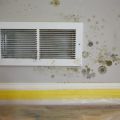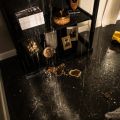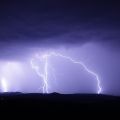6/25/2021
21 Facts About Mold that You Need to Know

6/25/2021
Mold growth is a recurring issue for property owners. While most mold species are harmless, some can cause material and structural damage when thriving inside a property. In addition, mold can also be a health hazard and give rise to a variety of allergies and respiratory conditions.
How much do you know about mold? The mold remediation experts at ServiceMaster by Reed have compiled the following mold facts for you.
1. The most common types of indoor mold are Alternaria, Aspergillus, Cladosporium and Penicillium.
2. Mold thrives on moisture, growing in damp areas indoors like basements, bathrooms and behind drywall after a water damage incident.
3. Mildew is a powdery, white-gray substance that can appear on the leaves of plants, which is an early stage of mold.
4. Mildew can easily grow on books, cardboard and fabrics. To reduce the risk of mold development, use water-resistant containers for storing old clothes and other items instead of cardboard boxes.
5. Mildew can be brushed off fabrics like clothing and curtains most of the time.
How much do you know about mold? The mold remediation experts at ServiceMaster by Reed have compiled the following mold facts for you.
1. The most common types of indoor mold are Alternaria, Aspergillus, Cladosporium and Penicillium.
2. Mold thrives on moisture, growing in damp areas indoors like basements, bathrooms and behind drywall after a water damage incident.
3. Mildew is a powdery, white-gray substance that can appear on the leaves of plants, which is an early stage of mold.
4. Mildew can easily grow on books, cardboard and fabrics. To reduce the risk of mold development, use water-resistant containers for storing old clothes and other items instead of cardboard boxes.
5. Mildew can be brushed off fabrics like clothing and curtains most of the time.
6. Mold found in homes typically appear brownish-green, black, greenish-gray and gray.
7. Mold is a fungus propagated by spores, acting as seeds to create new colonies.
8. Some molds can be toxic and cause health problems when their spores are inhaled. People most susceptible to mold-related health issues are those with allergies, asthmatic persons, children, pregnant women, the elderly and those with compromised immune systems or existing respiratory ailments. This is why it is important to call a mold remediation professional immediately.
9. Exposure to mold and its spores may cause cough, headache, fever, wheezing and flu-like symptoms. Mold can also trigger asthma attacks.
10. Stachybotrys chartarum, also called "toxic mold" or "black mold", appears as a greenish-black spot which grows in an area that has suffered heavy water damage. It requires professional mold remediation.
11. Mold growing on a shower curtain or in the tile's grout around a tub can be removed by a homeowner. Using bleach to remove mold must only be done in a well-ventilated room. Also, check if bleach etches the affected tile before using it to clean the area around the tub.
7. Mold is a fungus propagated by spores, acting as seeds to create new colonies.
8. Some molds can be toxic and cause health problems when their spores are inhaled. People most susceptible to mold-related health issues are those with allergies, asthmatic persons, children, pregnant women, the elderly and those with compromised immune systems or existing respiratory ailments. This is why it is important to call a mold remediation professional immediately.
9. Exposure to mold and its spores may cause cough, headache, fever, wheezing and flu-like symptoms. Mold can also trigger asthma attacks.
10. Stachybotrys chartarum, also called "toxic mold" or "black mold", appears as a greenish-black spot which grows in an area that has suffered heavy water damage. It requires professional mold remediation.
11. Mold growing on a shower curtain or in the tile's grout around a tub can be removed by a homeowner. Using bleach to remove mold must only be done in a well-ventilated room. Also, check if bleach etches the affected tile before using it to clean the area around the tub.
12. Adequate ventilation, such as running a fan, can help reduce mold growth in a room. In the bathroom, allow ventilation by opening glass shower doors. Keep the shower curtain open for it to dry completely to prevent mold from growing.
13. Mold may be growing in the basement if a musty odor is observed to be coming from it. Check for signs of water damage, such as leaks.
14. If a musty odor is present in your home, it is crucial to find the source of the smell or to locate the mold as soon as possible.
15. The Centers for Disease Control and Prevention (CDC) does not recommend mold sampling or testing for mold growth in residential homes.
16. Minimize mold growth by keeping indoor humidity levels below 45 percent.
17. An indication of high humidity levels in the home is the presence of condensation on walls, windows and other hard surfaces, which increases the possibility of mold growth.
18. Mold can grow in as little as 24 to 48 hours after a water damage incident.
19. Mold can develop in hidden areas, such as on carpet padding, behind drywall, within insulation and even throughout the HVAC system.
20. To reduce the potential for mold growth, add mold-inhibitors to paint before painting.
21. For safe and effective mold removal, contact a mold remediation company like ServiceMaster by Reed.
Mold Removal? Contact ServiceMaster by Reed Today
If you need immediate mold remediation services in Dothan, Alabama and surrounding areas, ServiceMaster by Reed offers 24-hour emergency services at (334) 500-3365.
- You may also connect with us online to schedule an appointment for mold removal and remediation.
- We are located in 2830 Horace Sheppard Drive Dothan, AL 36303.
- Preferred vendor for insurance companies in Alabama
- Certified by the IICRC
- State-of-the-art equipment and cleaning products
Don't know what to do next? We do. Contact us today.
Other articles and publications:
When a flood happens, there are some steps that you can take before the professionals arrive. ServiceMaster by Reed discusses what you should do after a flood below.
Learn tips for your small business to survive a disaster. Call ServiceMaster by Reed at (334) 500-3365 for Dothan, AL water, fire and mold mitigation service.
7/23/2021
Knowing what to do during the aftermath of an emergency can make all the difference. ServiceMaster by Reed has some tips to help protect you and your family when a disaster comes.
7/23/2021
How Thunderstorms Can Affect Your Business
9/28/2021
Learn how to keep warm during a power outage in Alabama. For Dothan flood damage restoration and repairs, call ServiceMaster by Reed at (334) 500-3365.
9/28/2021
Learn about what causes water damage incidents. For Dothan water damage cleanup & repair, call ServiceMaster by Reed of Alabama at (334) 500-3365.
8/25/2021







